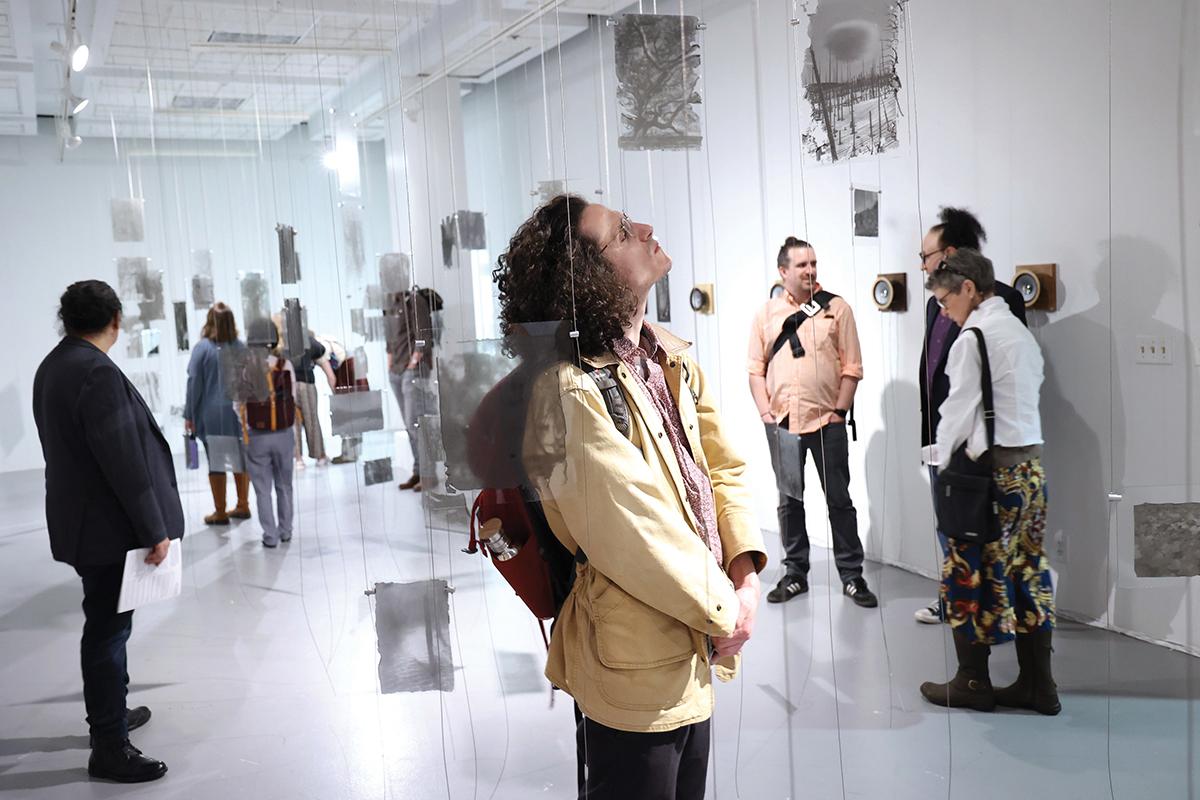
by Jenée Wilde, Senior Instructor, Department of English
During spring term, CSWS presented Haunting Ecologies: The Past, Present, and Future of Feminist and Indigenous Approaches to Forest Fire. This two-week event series included the 2023 Acker-Morgen Memorial Lecture as well as a panel discussion on “Native Ecologies.” Both events were presented in conjunction with Ghost Forest—a photography exhibit by Eugene artist Sarah Grew, featuring Jon Bellona’s sound installation Wildfire. The events marked the first time that CSWS and the UO Environment Initiative have partnered on environmental justice programming and was included as part of UO’s Environmental Justice weeks.
Opening the event series on April 25 was “Native Ecologies,” a panel discussion on Indigenous histories and approaches to fire management, knowledge production, and ecological stewardship. Held in Lawrence Hall, the event included native panelists Amada Lang, Joe Scott, and David G. Lewis, with sociology and environmental studies Professor Kari Marie Norgaard and moderator Kirby Brown, associate professor of Native American and Indigenous literary and cultural production. Immediately following the panel was the opening reception for the Ghost Forest and Wildfire exhibits in the LaVerne Krause Gallery.
The panel discussion began with a presentation by David G. Lewis, an assistant professor of anthropology, ethnic studies, and Indigenous studies at Oregon State University. He is a member of the Grand Ronde Tribe, descended from Takelma, Chinook, Molalla, and Santiam Kalapuya peoples. Lewis explained the role of fire in tribal management of wetlands in the Willamette Valley prior to settler-colonialism. In the late 19th century, European settlers drained the valley’s wetlands to create monocrop farming. “We destroyed a giant ecosystem that was homeland to lots and lots of wildlife, to tribes who utilized it for food, so we’re trying to do something to restore it today,” Lewis said. “Bringing back fire is a great start, but we have to bring the water back, too.”
Following Lewis was Joe Scott, a member of the Confederated Tribes of Siletz Indians and a descendant of the Rogue River Tribes of Southern Oregon, who currently lives and studies on Kalapuya Illahee as curriculum director for the Traditional Ecological Inquiry Program. In his presentation, Scott shared stories of what has been happening today in the realm of cultural fire and the efforts of tribes to restore traditional fire practices. After 175 years of settler-colonial fire suppression, we have a situation where massive wildfires destroy communities, human and non-human people, and the land. As a result, “fire becomes a war, and fire has never been like that,” Scott said. “Historically, fire is a tool and companion for making things happen on the land.” Today, regional tribes are rewriting the script of what fire can be by implementing cultural fire practices to manage and restore their lands to precolonial states. “It’s overwhelmingly amazing to be a part of these projects and seeing these things coming to life,” he said.
Rounding out the panel was a presentation by Amada Lang and Kari Marie Norgaard. Lang is a Karuk, Wiyot, and Konomihu Shasta Native and the Klamath Basin coordinator for Ríos to Rivers, providing outdoor adventure education through a traditional ecological knowledge perspective. She described her work with the Women-In-Fire Prescribed Fire Training Exchanges (WTREX) program held in Orleans, California. This is an intensive two-week training only for Indigenous women from around the globe, where they are able to gather knowledge of cultural burning and prescribed fire to share, practice, and preserve for future generations. “The tribe is really being on the forefront in wanting these ideas and epistemologies to be shown forth,” she said, “and we can’t do it just with allyship as such.”
Kari Marie Norgaard is a non-native professor of sociology and environmental studies who lives and thinks in Kalapuya lands at University of Oregon. She discussed her work as a consultant for the Northern California Karuk Tribe on tribal environmental policy since 2003. Norgaard is using climate change and awareness of fire and the relevance of Indigenous burning to try to advance changes in federal and state fire suppression policies. “When I see that smoke we had in 2020 that was so difficult for us to live through, that smoke is the smell of colonialism in my mind,” she said. “We non-native people have been in denial about so many aspects that have happened in this place where we’re living on Kalapuya lands. The negation of colonialism and the return of Indigenous epistemologies and ecologies—all of those things are coming back. Yes, it doesn’t stop [wildfires], but it’s work to be done. The return of fire can very much be about healing.”
The “Native Ecologies” event concluded with a reception and opening of the Ghost Forest photography exhibit. Following the devastating 2020 wildfires in Oregon, Grew collected coals from the fires that she then used, through extensive research and experimentation, to create carbon prints of images taken of the burned forests. Printed as lantern slides, Grew said the forest memory “is held captive on sheets of glass, accentuating both the fragility of life and our precarious position.” Adding to the impact of these haunting photographs was a 48-foot-long speaker array that plays back a wave of fire sounds at speeds of actual wildfires. An instructor of audio production in the School of Music and Dance, Bellona said the sound installation Wildfire allows viewers “to embody the devastating spread of wildfires through an auditory experience.”
Closing out the event series was the annual Acker-Morgen Memorial Lecture, held on May 2 in Lawrence Hall. M Murphy, a professor of history and women’s and gender studies at University of Toronto, spoke on “Desire in the Aftermath of Environmental Violence.” Murphy is Métis from Winnipeg, Manitoba, a citizen of the Red River Métis, and French Canadian. As co-director of the Technoscience Research Unit, which uses social justice approaches to science and technology studies, as well as co-director of the Indigenous Environmental Data Justice Lab, Murphy studies the relationships between chemical pollution, colonialism, and technoscience on the lower Great Lakes in a region known as Chemical Valley.
In the 1850s, colonial surveyors found oil on the Anishinaabe reservation, and land speculations quickly turned the region into the world’s first commercial oil field and site of some of the oldest refineries. Today, companies in Chemical Valley refine more than 40 percent of Canada’s petrochemicals. The reserve for the Anishinaabe peoples is surrounded by refineries, waste facilities, and land and water pollution from decades of spills, releases, accidents, and flares—all of which companies have historically refused to acknowledge or take responsibility for.
“Our work is about confronting the erasure of violence that is absolutely apparent to the senses,” Murphy said. “If you are there, it’s impossible not to know it. But somehow in the study of it—in the data, in the air monitors, in the written forms—it is erased.”
Chemical Valley only exists because of 150-plus years of settler-colonial violence that cleared the area of Indigenous peoples, settled the land, put native children into residential schools, made speaking native languages illegal, and much more. However, Murphy’s Indigenous-led lab at the University of Toronto doesn’t focus on these very real injustices and refuses a deficit model. Rather, they focus on a desire-based approach to the study of environmental violence.
“We ask, what might an anticolonial, feminist, queer orientation to chemical pollution be composed of, if the tactic isn’t going to be about sharing stories of harm or deficit and so on,” Murphy said. One can think of desire as individual and subjective—such as a desire for environmental violence to end by burning it all down. However, the lab’s approach is focused instead on desire as a collective assemblage of experiences that complicates our understanding, of practical desires as well as impossible desires, and of solidarity and collectivity that have long histories in Indigenous, feminist, and queer research and activism. “A solidarity of desires is needed to do the work,” Murphy said.
The Haunting Ecologies event series was cosponsored by the UO Environment Initiative, Center for Environmental Futures, College of Design, Native American and Indigenous Studies, Just Futures Institute, a CAS Program Grant, and the Barbara and Carlisle Moore Chair in English.
—Jenée Wilde is a senior instructor of English and research dissemination specialist for the Center.

